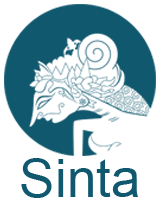Effect of additional seaweed on the chemical properties of dodol pisang mas bali (Musa paradisiaca L.)
Abstract
Dodol is a processed food belonging to the type of semi-wet food, consisting of a mixture of flour, coconut milk and sugar that is dried by cooking. Based on the main ingredients, dodol is divided into two groups, namely dodol made from glutinous rice and dodol made from fruits. One type of fruit that can be used to make dodol is banana. The aim of this study was to determine the effect of seaweed addition on the chemical and organoleptic properties of Mas Bali Banana Dodol. This study was designed using a completely randomised design (CRD) with a single factor, namely the addition of seaweed in the production of banana dodol, consisting of 5 treatments as follows 5% (P1), 10% (P2), 15% (P3), 20% (P4) and 25% (P5) seaweed addition. The parameters measured included chemical properties (moisture content, ash content and fibre content) and organoleptic tests (aroma, taste, colour and texture). The test results were then analysed using ANOVA at a 5% real level and, if there were significant differences between treatments, further tested using BNJ at the same real level. Based on the results of the analysis, it is known that the addition of seaweed has a significant effect on all the chemical and organoleptic properties of the grapefruit-banana dodol studied. The higher the addition of seaweed, the higher the water content, ash content and fibre content of the grapefruit-banana dodol, while the colour of the dodol becomes darker. In terms of texture, the higher the amount of seaweed used, the more chewy the texture of the resulting grapefruit banana dodol. In conclusion, P5 is the best treatment, most preferred by the panelists, with a seaweed addition of 25%, giving a moisture content of 47.33%, ash content of 2.28%, fibre content of 13.76%, with a preferred flavour and taste, a very brown dodol colour and a chewy texture.
Keywords
Full Text:
PDFReferences
Adwyah Kurnia, Enny Sumaryati. (2016). Studi Pembuatan Permen Jelly Dengan Variasi Konsentrasi Sari Kulit Buah Naga. Jurnal Ilmu-Ilmu Pertanian Universitas Widyagama Malang. Vol 3, No. 4, Hal 60-75. Astawan dan Wahyudi 2013.Sifat Fisik, Kimia dan Organoleptik Dodol Kawista Formulasi Rumput Laut. Jurnal Pangan Vol 3 No. 22 hal 1-10
Afifah, K., Sumaryati, E., & Moh. Su’i. (2017). Studi Pembuatan Permen Jelly Dengan Variasi Konsentrasi Sari Kulit Buah Naga. Agrika, 11(2), 206–220.
Ardiansah, B., & Marianah, M. (2023). The addition of cashew pseudo-fruit by different concentration towards chemical and organoleptic quality of dumbo catfish floss. Journal of Agritechnology and Food Processing, 2(2), 83–95.
Anggadiredja,Purwoto dan Istini, (2014). Rumput laut. Penebar, Swadaya. Jakarta,
BPPT. (2011). Manfaat dan pengolahan rumput laut. Jurnal pangan dan agroindustri, 2(3): 1-7
Cicilia, S., Basuki, E., Alamsyah, A., Yasa, I. W. S., Dwikasari, L. G., & Suari, R. (2021). Karakteristik cookies dari tepung terigu dan tepung biji nangka dimodifikasi secara enzimatis. Journal of Agritechnology and Food Processing, 1(1). https://doi.org/10.31764/jafp.v1i1.5960
Departemen Perindustrian Republik Indonesia. (2013). Standart Nasional Indonesia Dodol. Jakarta.
Fibri, P. Purwadi dan Lilik, E. R. (2014). Pengaruh Penambahan Tepung Rumput Laut Terhadap Kualitas Fisik Dan Organoleptik Dodol Susu. Skripsi, Fakultas peternakan, Universitas Brawijaya.
Ghufran M, Kordi K. (2010). Budidaya Biota Akuatik Untuk Pangan, Kosmetik Dan Obat-Obatan. Lily Publisher. Yogyakarta
Hambali. (2014). Membuat Aneka Olahan Rumput Laut. Penebar Swadaya. Jakarta.
Hanafiah, K.A. (2005).Rancangan Percobaan Aplikatif. Raja Grafindo Persada. Jakarta.
Haryadi. (2016). Teknologi Pengolahan Beras. Gadjah Mada University. Press. Yogyakarta.
Istini Zahina dan Suhaimi. (2013). Karakteristik Permen Jelly Dengan Penambahan Iota Karagenan Dari Rumput Laut (Eucheuma Spinosum). Jurnal of Fisheries Science and Technology,Vol 2 No 1 Hal 30-33.
Maharani S. L., Giyarto, Jayus. (2017). Sifat Fisik, Kimia Dan Organoleptik Dodol Hasil Variasi Rasio Tomat Dan Tepung Rumput Laut. Jurnal Agroteknologi. Fakultas Teknologi Pertanian. Universitas Jember. Jember
Miranti. (2020). Pengaruh suhu dan lama pengeringan terhadap mutu permen jelly buah nangka. AGRILAND Jurnal Ilmu Pertanian, 8(1).
Nurhayati, N., Marseno, D. W., Setyabudi, F. S., & Supriyanto, S. (2018). Pengaruh Steam Blanching terhadap Aktivitas Polifenol Oksidase, Total Polifenol dan Aktivitas Antioksidan Biji Kakao. Jurnal Aplikasi Teknologi Pangan, 7(3). https://doi.org/10.17728/jatp.2314
Prabawati, S., Suyanti dan D. A. Setyabudi. (2013). Teknologi Pasca Panen Dan Teknik Pengolahan Buah Pisang. Balai Besar Penelitian Dan Pengembangan Pascapanen Pertanian. Badan Penelitian Dan Pengembangan Pertanian. 54 Hal.
Rahardjo, C. R. (2016). Faktor Yang Menjadi Preferensi Konsumen Dalam Membeli Produk Frozen Food. Jurnal Manajemendan Start-Up Bisnis, 1(1).
Rahman, S., & Dwiani, A. (2022). Mutu teh celup dengan campuran bubuk sereh (Cymbopogon citratus) dan bubuk kelor (Moringa oleifera). Journal of Agritechnology and Food Processing, 2(1). https://doi.org/10.31764/jafp.v2i1.8949
Rifni N. (2013). Studi Pembuatan Dodol Pisang. Jurnal. Jurnal Teknologi Pangan. FAPERTA. UNISI
Rudianto, dkk. (2015). Evaluasi Mutu Dodol Berbasis Tepung Ketan Dengan Buah Pedada (Sonneratia Caseolaris), Fakultas Pertanian, Universitas Riau, Vol. 2, No.2, Hal 1
Saputro, P. S., & Estiasih, T. (2015). Pengaruh polisakarida larut air (PLA) dan serat pangan umbi-umbian terhadap glukosa darah: kajian pustaka. Pangan Dan Agroindustri, 3(2).
Satuhu, S. dan A. Supriyadi, (2014). Pisang : Budidaya, Pengolahan, dan Prospek Pasar. Penebar Swadaya. Jakarta
Setiavani G. (2018). Teknologi Pengolahan Dan Peningkatan Nilai Gizi Dodol. Jurnal Pangan, Vol. 27, No. 3, Hal: 225-234
Soekarto, (2008). Penilaian Organoleptik untuk Industri Pangan dan Hasil Pertanian.Institut Pertanian Bogor. Bogor.
Sudarmadji, S.B. dan H, Suhardi. (2013). Prosedur Analisa Untuk Bahan Makanan dan Pertanian Edisi ke-empat. Liberty. Yogyakarta.
Suyanti dan Ahmad Supriyadi. (2014). Pisang Budidaya, Pengolahan dan Prospek Pasar. Edisi revisi. Penebar Swadaya. Jakarta
Winarno F. G. (2013). Teknologi Pengolahan Rumput Laut. PT Gramedia Pustaka Utama. Jakarta
DOI: https://doi.org/10.31764/jafp.v3i1.16305
Refbacks
- There are currently no refbacks.
Copyright (c) 2023 Syahlan, Sari, Marianah

This work is licensed under a Creative Commons Attribution-ShareAlike 4.0 International License.
JAFP is indexing in the following databases:











